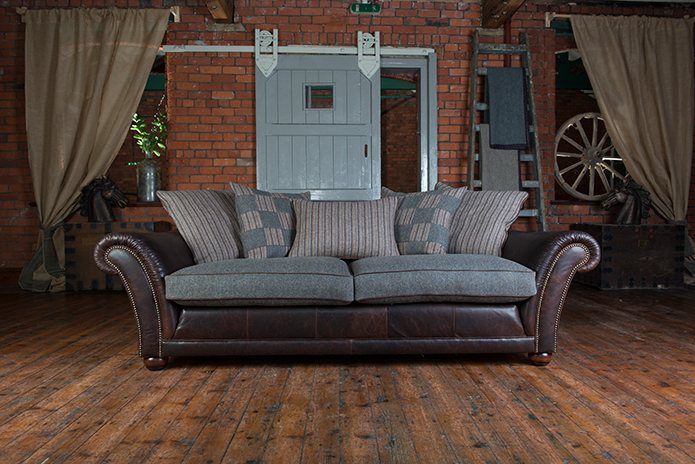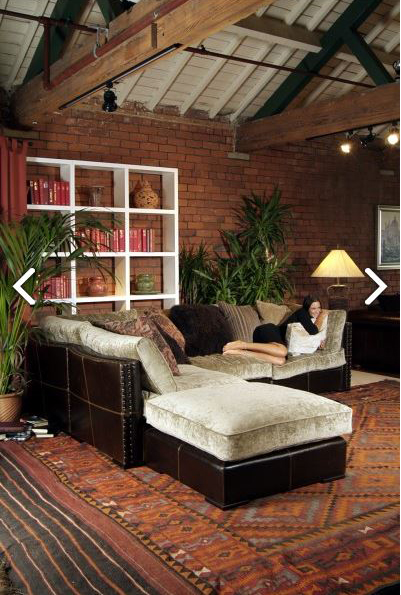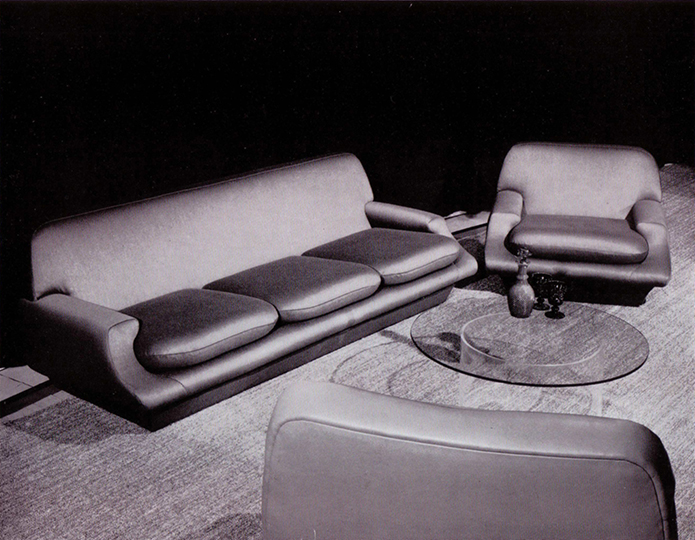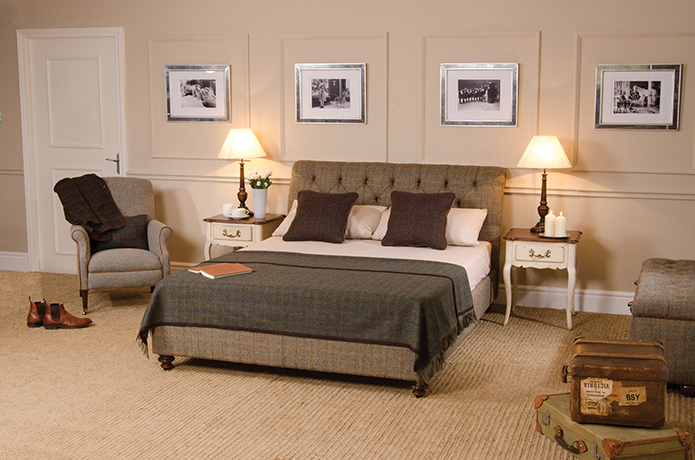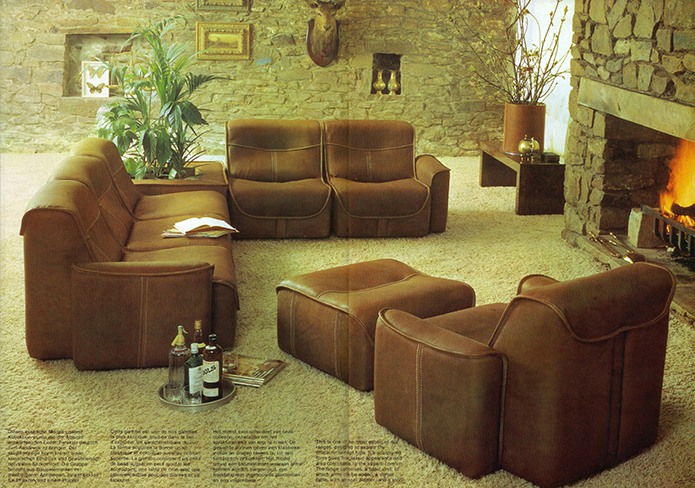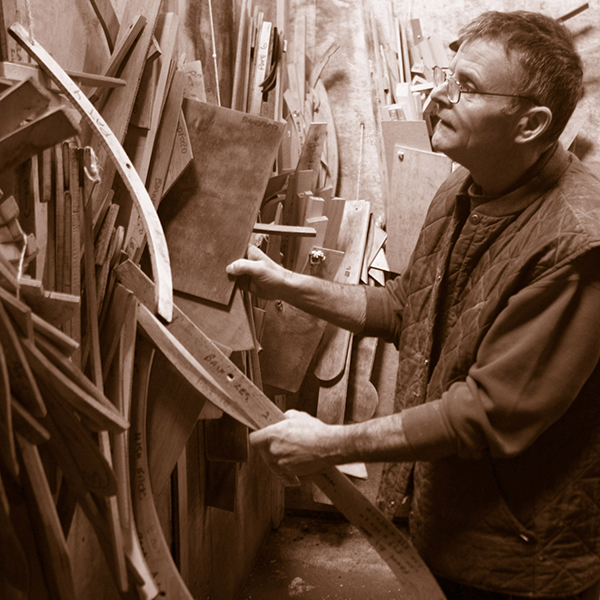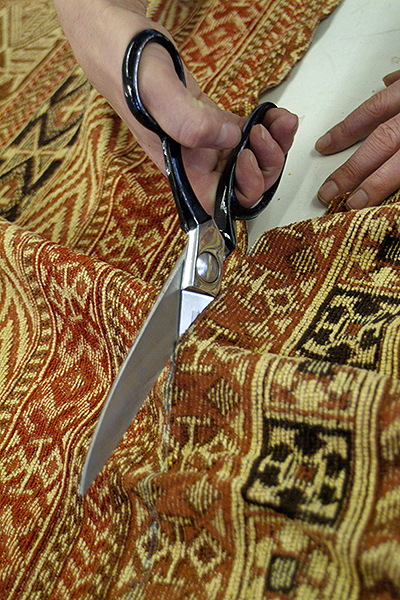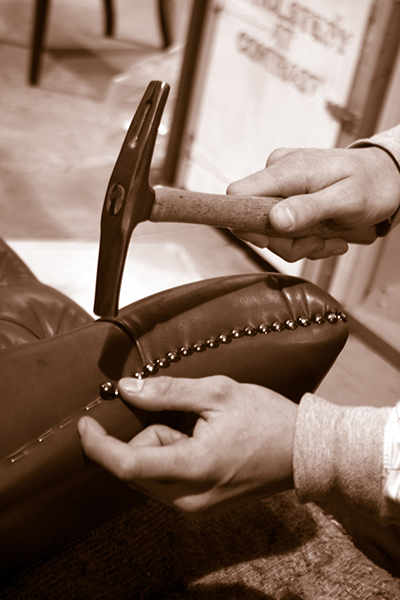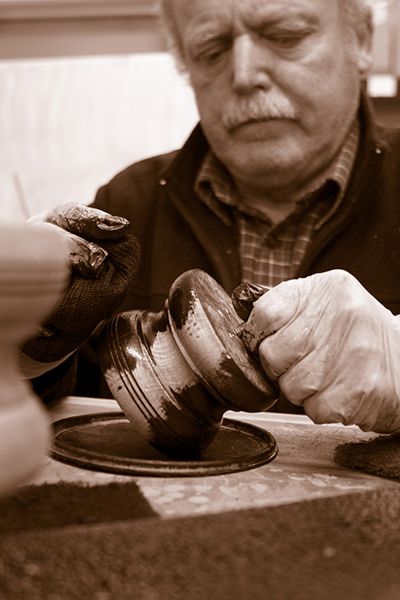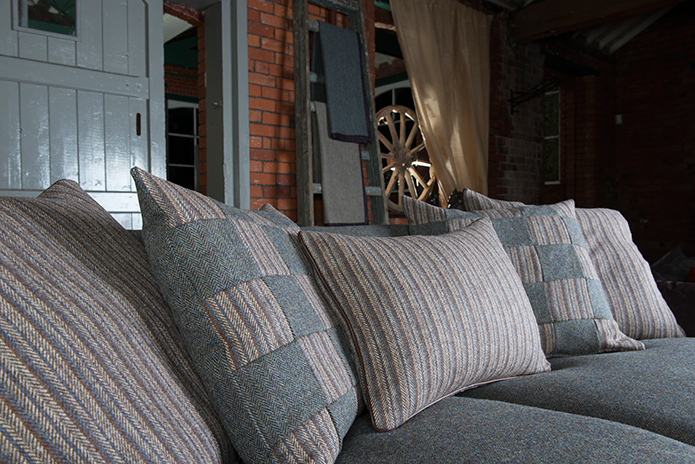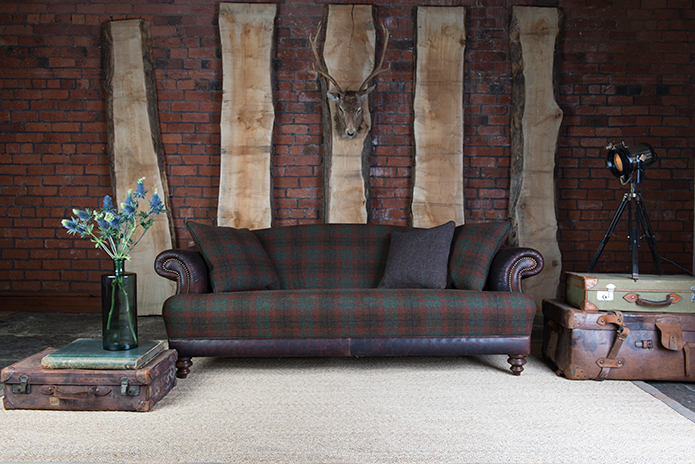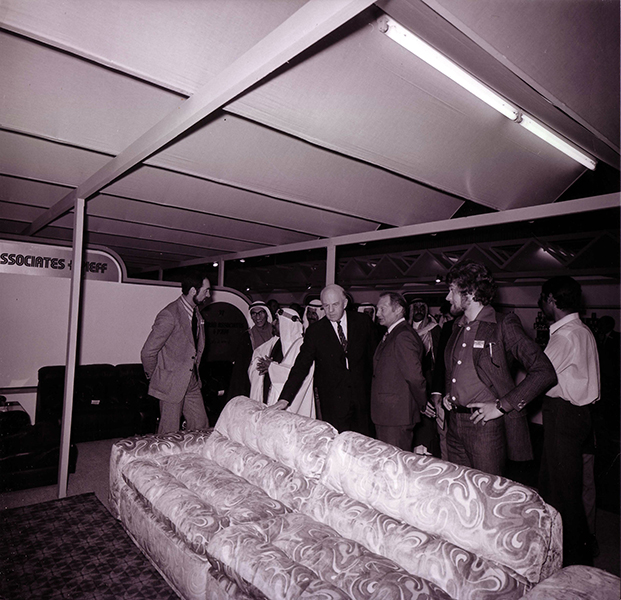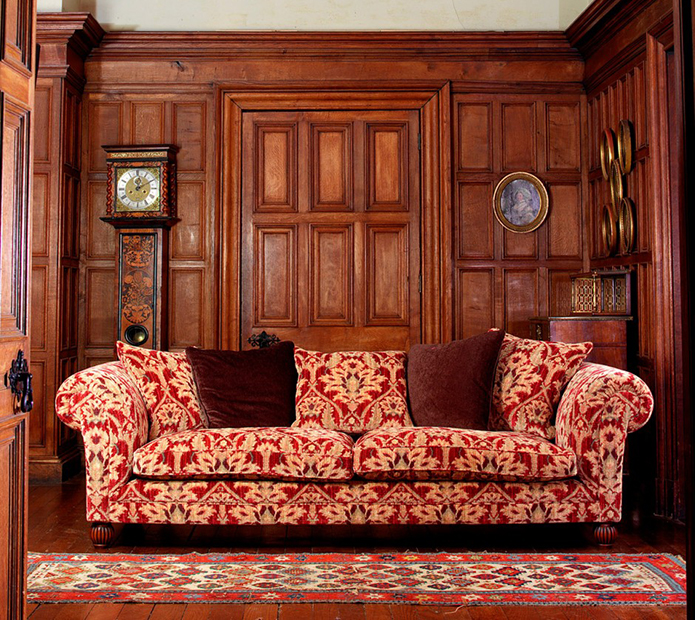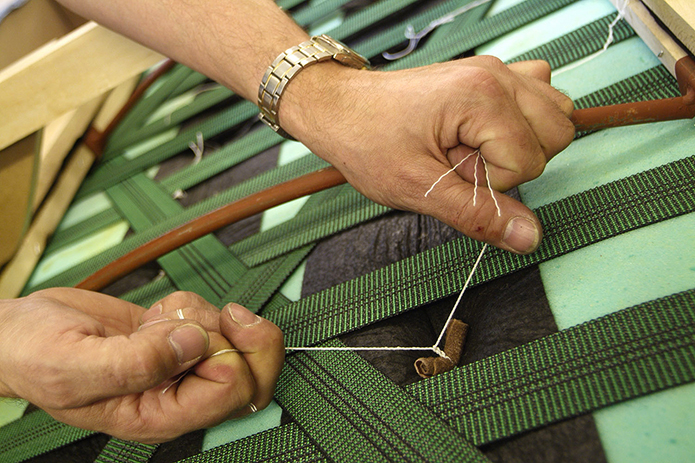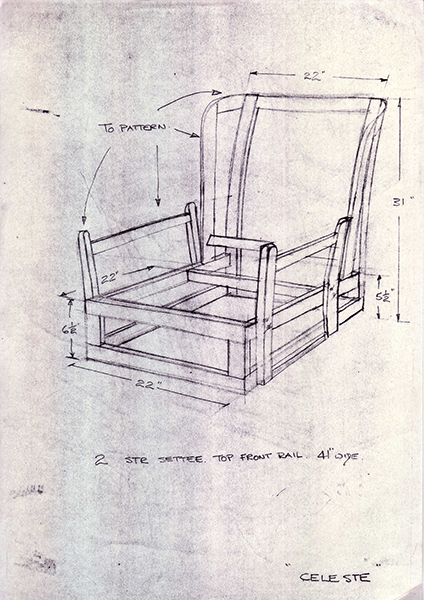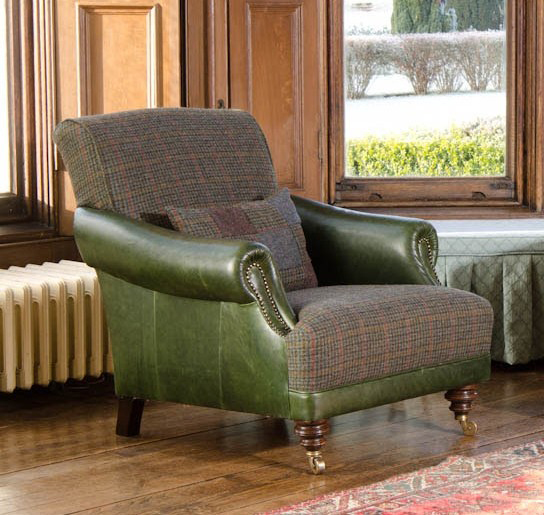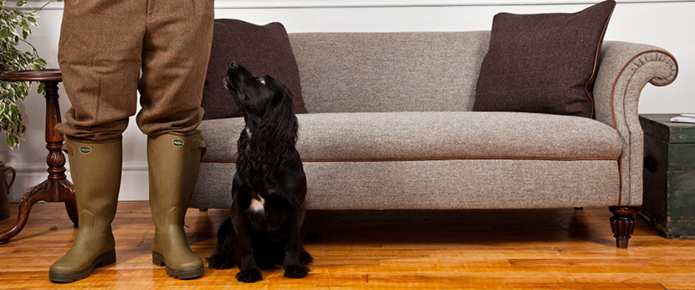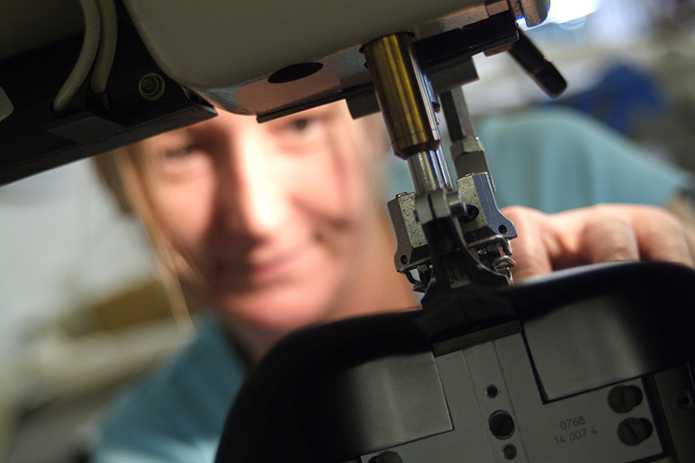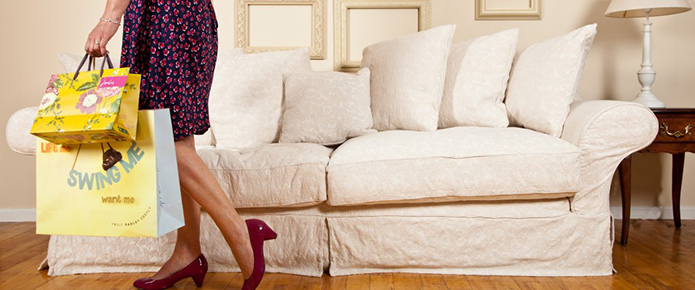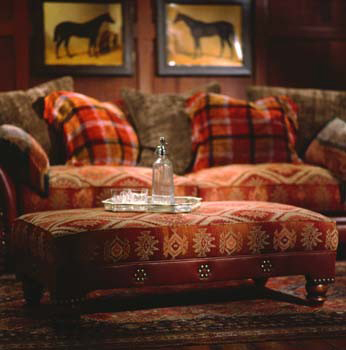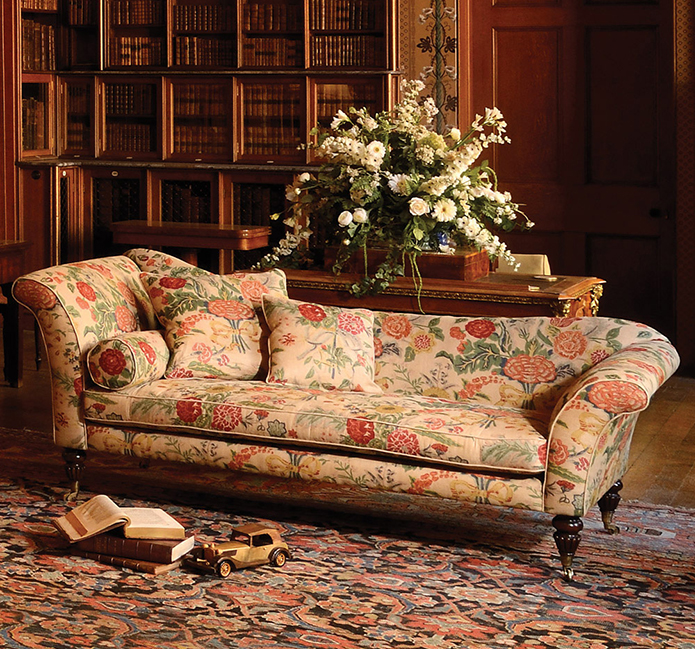
Sumptuous in looks and comfort, classically elegant and built to last the tests of time, as well as the fickleness of fashion, a Tetrad piece looks equally at home in a medieval baronial hall or a modern cosy lounge. As with all things of ‘class’, a Tetrad piece of furniture timelessly fits in anywhere due to its subtle quality and down-to-earth warmth.
Tetrad’s Lancashire workshop, comprising of innovative and passionate designers, as well as highly skilled craftsmen including, woodworkers, fabric cutters and upholsterers, now in the second generation, has been producing some of the world’s highest quality sofas, chairs and stools for almost five decades.
Only the best sustainable materials are used, sourced from all over Britain; from air-dried beech for the frames to the highest quality leathers and textiles for the coverings. Most recently, Tetrad have incorporated the ever-popular Harris Tweed fabric within their designs, which has proved a huge success all across the world, and in turn provided a recipe for success for iconic British brands to work together in what is an extremely competitive global market.
All facets of the production are expertly crafted by specialist individuals to create iconic pieces that are beyond function, certainly beyond fashion, but instead are understated yet at the same time statement pieces. A Tetrad piece of furniture has been built to last the generations; generations that will no doubt sit, lie and, dare we say it, inevitably jump-up-and-down upon them, making them modern-day heirlooms to be lovingly admired, but more importantly lovingly used in your sitting room.
Here, through this interview with Janus Cooper, a Director at Tetrad, and the son of one of the founding partners, we explore what it means to be at the helm of a traditional, craft-based British business that stays true to its origins, yet still manages to evolve and maintain its contemporary edge…
Firstly, for those readers that aren’t familiar with Tetrad, please can you briefly explain the history of your company, and what makes you different from other furniture makers?
Tetrad was founded in 1968, which was a period going through a revolution in the furniture industry. It was a buoyant time, people had a lot more money, certainly more than in previous years, and it was also a very trendy period. My father and three other partners established Tetrad to create modern leather furniture at the premium end of market to tap into this new demand.
I would go as far to say that Tetrad were pioneers in the furniture industry; we were a lot more innovative than our competitors back then, and still are, creating a lot of new, innovative products. Not every design was a success, granted, but those that did were extremely popular and created the foundation for the company to expand.
What also makes us different is that we make 100% of our products in the UK, whereas the majority of our competitors, if not all, can’t really say that, as they will buy in a lot of component parts, such as fabrics, from abroad, whereas we use solely British fabrics, like Harris Tweed. To sum up what makes us different, it would be our innovation, the extensive range and our customer service. When you have a product with the authenticity of ours, it’s far easier for a customer to justify buying one, rather than buying an anonymous, production line-made alternative.
What would you say are your values and ethics when it comes to designing and making Tetrad furniture, and is the ethos behind the company today consistent with its origins?
Our values and ethics are certainly consistent with when the company was first founded. We are pioneers in furniture trends, and continue to innovate and push the boundaries in both design and production, which is helped by the large number of young people we have working in the business, as their input certainly changes the way we look at things, which is a positive for us.
Ultimately, it’s all about the products for us. If you have a great product, it automatically delivers the sales, and that’s philosophy has always been at the core of our business. It’s like the car industry, if you design a great car, and put the investment in to market it, people will buy it. We’re no different in that respect; our investment in product design and development is massive.
Your furniture is still constructed using classic hand-crafted joinery techniques, but have your practices changed to keep up with new technologies, whether in production or design, or both?
We embrace modern technology, for instance, we use modern CAD systems to help with design, and utilise modern machinery to assist in production allowing us to optimise the cutting of wood and fabrics, but the underlying strength in our business is our level of skill and craftsmanship that goes into making each piece of furniture.
We continue to use traditional methods of manufacturing; all our frames are glued, screwed and dowelled, for instance, and we ensure that the necessary woodworking skills are passed down. There is nothing revolutionary about our products in that sense; everything we put in is traditional and we aim to make the products as recyclable as possible.
Such is the quality of our traditional workmanship, if someone is comfortable with woodwork, then it should be fairly easy to self-repair our furniture in the event of an accident; using the car analogy again, it’s easier to repair a care that’s 6o years old than it is a new one, and our furniture is no different. Not that we expect there to be any problems; we have people coming back to us after 40 years saying their sofas are still in great condition. From a manufacturer’s perspective, you could say we’re shooting ourselves in the foot by making our furniture built to last generations, as you’d probably rather people change their furniture every 10 years, but that’s not what we’re about.
When it comes to cutting fabrics for the furniture, we use French garment cutters for best optimisation of cutting the raw material using a lay plan for most of our fabrics, but this isn’t possible with our Harris Tweed range, as every piece of tweed is different and the fabric has to be cut by hand and pattern matched, rather like the way Savile Row cutters prepare a piece of fabric to be made into a suit.
All of our furniture is hand-finished; for instance, in the finishing process we apply individual studs by hand, rather than strip studding, which would be the norm these days. A lot of craftsmanship goes into the final finishing of the product, and that’s what distinguishes our products from the competition.
Rather than operate a production line, we have one person responsible for each key aspect of making the chair; again, similar to the way Savile Row tailors operate with their cutters, trimmers, tailors and finishers. For instance, we have one person responsible for the frame, one person for cutting and sewing, and one person for upholstering. In total there will be at least three people making each chair. We don’t operate a production line like the majority of our competitors, where one person will stuff cushions, another will stuff the chair arms etc. We like to have full traceability in the making of our products.
Tetrad has made the transition from being a small furniture workshop in Lancashire to occupying a leading position as a fine furniture and upholstery business, not just in the UK, but globally, employing over 200 skilled staff in Preston. Why do you feel the Tetrad brand has been so universally successful?
I believe our brand is successful as we constantly deliver a quality product, and what we produce can’t easily be copied. The brand follows through into a number of areas: the values we place on our workforce, our suppliers and our customer base.
Branding is not just about brand awareness through adverts and magazines though; it’s about growing that awareness slowly over time through delivering, consistently, high quality and innovative products. We are seen as the leading brand in trade circles, and that speaks volumes.
From a consumer perspective though, we are also a sub-brand to the retailer. If a consumer goes into a John Lewis store, they are buying into the John Lewis brand and we are coming under that. We are therefore trusting of our retailer brands, in the same way as our supplier brands, such as Laura Ashley and Harris Tweed, trust in us. I believe we are a much stronger product with such brand associations.
Looking at your website and brochure, the imagery of your furniture feels very personal and genuine, being used in everyday scenarios in a home, rather than just for functional purposes. Was there a conscious decision on your part to emphasise the integrity behind the products within your marketing?
Over a period of time, we’ve been able to amass a considerable portfolio of shots, the vast majority of which were taken in homes owned by friends of ours, rather than fake shots in a studio, and as they are in real homes, I think the integrity comes through.
Our latest photoshoot, showcasing the product launch of our Harris Tweed collection, has been a slight departure from previous shoots. Mark Hogarth, the Creative Director of Harris Tweed Hebrides, is a former model, and he got involved in the shoot, which was really beneficial. We’ve gone back to the 1970s in terms of style and feel, and he made it look different to our previous shoots; slightly more individual, but just as friendly.
Where do your designers find their inspiration for such beautiful pieces of work and who, or what, have been their creative influences, for instance is there a particular era you draw from?
There are various influences – for instance, we draw inspiration from our extensive archives; we have a huge library of products that have evolved over time as we’ve managed to produce thirty new pieces each year for the past fifty years, so that’s a lot of products in our archive which we’re able to back through, which we do regularly. We are also often looking at magazines for inspiration, and listening to what our customers tell us they are looking for.
However, I think travelling to trade shows around the world is the most important aspect for us to get a feel for what’s happening in overseas markets. We visit High Point Market in North Carolina twice a year, as well as Maison&Objet Paris and Milan Furniture Fair trade shows and bring back ideas, not to copy, but purely for inspiration.
This is exactly what the founders of Tetrad did in the 1960s, which was quite unusual back then, and they were certainly ahead of their time when it came to travelling, getting ideas, and bringing them back to the UK. The competition at the time weren’t doing this, but now it’s far easier, of course. I remember my father and his business partners being away for large periods of time as a child, always looking at ideas, not all of which worked, perhaps 1 in 10 didn’t, but the majority did.
How difficult is it to find the subtle balance between creating furniture that is both characterful and classic-looking, yet comfortable and suitable for modern homes?
Our products are certainly characterful and classic pieces, but comfort and styling isn’t difficult, as have been doing it for such a long time, and we’ve got that aspect down to a fine art. We like to think we are producing heirlooms of the future; pieces that aren’t too modern, but with a clean, classic style that can be handed down through the generations, and won’t go out of date.
Of paramount importance is producing a high quality product that will stand the test of time, but paying close attention to the detail of the finish. We get a lot of inspiration from the fashion industry in that respect. For instance, we incorporate leather piping and leather buttons, and now when you lift a seat cushion, there is a leather lining underneath, so it’s not just about what you see on the outside, we place close attention to all aspects, inside and out.
What comes first for you – the materials or the design idea?
That’s a difficult question to answer, as they are both important. Sometimes it’s the materials, sometimes design, particularly when our designers come up with a new shape and we have to find a fabric for it.
Our collaboration with Harris Tweed is a perfect example of when materials took precedence though, and we needed to make the design fit the materials. Harris Tweed is an expensive cloth, due to the artisanal way that it is produced, and it is wider than most fabrics. We therefore didn’t want to treat it as a normal fabric and had to think a lot harder how we could use the fabric and make it work, resulting in us altering our designs accordingly.
Your collaboration with Harris Tweed Hebrides has clearly been very successful and you have gone on record to say that it has been transformational for your company as well as being extremely important for the artisanal Harris Tweed industry. How did this collaboration come about?
My father and I were exhibiting at Maison&Objet Paris and someone arrived at our stand wearing a Harris Tweed jacket. As it was very hot, they asked if they could leave their jacket at our stand for a while. Handing it over, my father and I both commented that we liked the look of the jacket and noticed the Harris Tweed label. A bit later on that day, we were visiting another stall, and noticed someone else had an item of Harris Tweed with them, a handbag, which again looked really nice, and stirred our imaginations. Harris Tweed was clearly very much in vogue, and we knew it was a route we had to go down for Tetrad. We were already working with other wool products, so it was complementary to that, and in fact the first ever piece created by Tetrad was in tweed surprisingly, and not leather, so there is some history there. Two weeks after the trade show, we flew up to the Outer Hebrides and met up with the Harris Tweed Hebrides creative team and we placed our first order with them. I guess in a way it was an accidental collaboration, but then again, maybe not; perhaps it’s just another example of how getting away from the office and travelling around the world provides an opportunity to find inspiration.
It has definitely been a successful collaboration, which has helped us grow by 30% in the past year alone, without any detrimental effect on existing sales orders, so it’s certainly been positive incremental growth for us. Harris Tweed Hebrides are fantastic people to work with, and I can’t think of any quality issues at all, which is very rare with a handwoven product, and especially as we are using 6,000 metres of fabric each week.
Is this model, collaborating with classic British textile manufacturers, one that you will replicate in the future, and do you believe this is a recipe for success that other British industries should be looking to emulate to boost sales in overseas markets?
I can’t actually think of another supplier that has the same brand and heritage as Harris Tweed in the UK, or world, for that matter, and it will be hard to find such a good partnership, but we would certainly like to. We work with a lot of great heritage producers, such as the Lancashire mills which have a long history of producing cottons, but they don’t have the same brand awareness as Harris Tweed, which is entirely unique in the artisanal way that it is produced.
Without doubt though, the collaboration model with other British heritage producers is a good thing. Certain markets, such as Russia, China and Japan, absolutely love the whole ‘made in Britain’ aspect. I noticed that one of our competitors has collaborated recently with Liberty of London, which makes perfect sense due to the individual Liberty print, and there’s a lot history attached to that. If two parties can get together, then they will be stronger as a brand together than stand-alone.
How important is maintaining production in the UK to either you personally, or to your brand?
It’s extremely important to maintain production here in Britain for me personally, as well as for the company; maintaining jobs here in Lancashire is crucial to us, and I think that it allows us to achieve a premium price for our products as well.
There is another aspect to this, which is having control over our products – using British suppliers, and having production based here, gives us greater flexibility in getting our products to market, time-wise. For instance, if we get a brief from a retailer we can get our products onto the shop floor within two months with British-made products, whereas it would take us six-to-eight months if we were dealing with Far East suppliers. Furthermore, if we were buying from the Far East, we’d also have to make a massive commitment to stock holding, which isn’t ideal, as within furnishings people want flexibility, so the quantities we’d be required to hold may not be appropriate for us.
Aside from the flexibility of working with British fabric manufacturers, we can also be assured of the quality, and from a legal perspective, it’s also a lot easier to make products here that conform to regulations in Britain, than in the Far East, as fire regulations are very strict in the UK.
Finally, how do you foresee the future of Tetrad and its likely evolution?
We’ll continue to evolve as a business. Our partnership with Harris Tweed is set to continue to grow over the next few years, based on our sales forecasts, which are extremely accurate based on our footprint in stores. Aside from this collaboration, which has lots of potential, there are markets that we’d like to further expand into, such as the Far East, Northern Europe and Russia, although the latter has been challenging due to the demise of the Russian Ruble recently.
We don’t have any plans for stores, as we don’t sell directly to consumers, and want to stay focussed on manufacturing and supplying to retailers, although we would like to break into the contract market, supplying our products to hotels, interior designers, hospitality events etc. It’s a different marketplace, but we have the right product, and we know there is a big market for our products in the refurbishments of hotels, for instance. We have hired someone to focus on this for us to get the product to market, so we’re confident this will be a great opportunity for us.
Thanks to Janus Cooper for taking time out of his busy schedule to answer our questions. All images © Tetrad.

